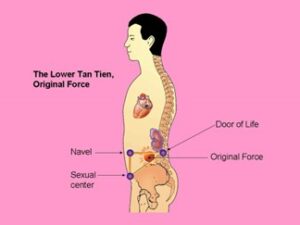How to Find, and Breathe With, the Lower Tan Tien
Taoists describe three tan tiens — energy centres within the body:
- Lower Tan Tien – located around the navel, serving as the body’s primary energy reservoir.
- Middle Tan Tien – centred around the heart, associated with emotional energy and compassion.
- Upper Tan Tien – situated near the pineal gland in the head, linked to higher consciousness and spiritual insight.
In the early stages of practice, the lower tan tien is given primary focus (which is often referred to, because of this importance, simply as “the tan tien”). This is because, through the internal experience of lineages of Taoist sages, it was discovered that:
- All the energy channels of the body meet here; as such it is the central switchboard for the entire energy system.
- It is the centre at which the most amount of energy can be stored.
- It is the site of our “original force” – the quantity of energy that we were born with to spend over our lifetime.
- It is the site where energy can be “cooked” or processed into more refined forms of energy with more potency within the body. For this reason, in Taoist lore it is said that an alchemical “cauldron” sits here.

[Image from Mantak Chia]
Let’s now look at how to find this centre of energy in the body, and how to breathe with it.
Practice Guide
Please watch the video below for this practice.
[INSERT VIDEO]
Written descriptions of these exercises can be found at the “Exercise Files” tab.
After completing the practice, please write your experience in the Course Journal.
In the final exercise, or anywhere throughout these exercises, did you feel tingling coming out through your fingers? Could you sense the movement of Qi out through your fingers?
If so, congratulations! You have just witnessed the secret behind Bruce Lee’s famous “1-inch punch”.
The 1-inch punch is an anomaly – the amount of force with which Bruce Lee could send an opponent flying across the room is more than what is physically possible from that distance using muscle power alone. The demonstration proved that something else was going on – another force is present, beyond the physical.
The truth is that Bruce Lee would have had to have spent countless hours filling up his tan tien with energy to have been able to collect enough force to move a man across the room. However, the technique is basically the same as what you have just done.
You could say that feeling tingling out through the fingers is like a snowflake’s worth of energy… but many snowflakes together cause an avalanche! And an avalanche can destroy a city. So, yes, a snowflake can destroy a city, but only when packed together with trillions of other snowflakes.
In the same way, regularity of practice and cultivation of energy at the lower tan tien can cause enough force to send a man flying.
